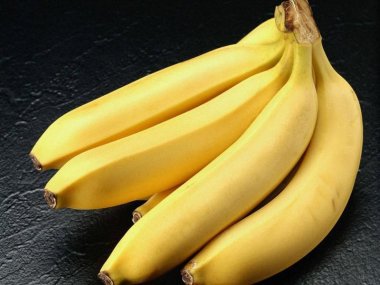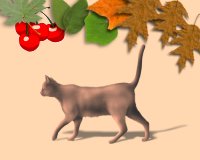Yes, We Have No Bananas!
 Cavendish-banaaneja
Cavendish-banaaneja"Yes! We have no bananas
We have no bananas today!!
We have string beans and onions, cabBAges and scallions
And all kinds of fruit and say
We have an old fashioned toMAHto
A Long Island poTAHto, but
Yes! We have no bananas
We have no bananas today!"
Banaani on laajimmin syöty ja halvin hedelmä nykyään. (Mikäli sitä nyt voi kutsua hedelmäksi, se on virallisesti pohjushedelmä.) Sillä on pikku ongelma. Se saattaa kadota lähivuosina.
Banaanit sinänsä eivät katoa, mutta kaupallisesti myytävänä tuotteena niillä on vakavia ongelmia. Koska banaani ei tuota siemeniä - se on steriili - ja sitä lisätään juurakoista, banaanit ovat kaikki klooneja. Eri puolilla maailmaa on vielä villejä, siementäviä banaaneja, mutta niiden määrä luonnossa vähenee koko ajan, koska sademetsiä hävitetään. Tällä hetkellä viljelty kaupallinen lajike on Cavendish.
Banaanit ovat haavoittuvia sienilajikkeille, jotka leviävät plantaasheilla. Koska banaanit ovat toistensa klooneja, nille ei kehity vaihtelua, joka suojaisi osan kasveista. Kun sieni leviää alueelle, banaanit ovat menyttä. Lisäksi sienirihmastot pysyvät maaperässä, joten koko alue on lopullisesti saastunut tälle kasville.
Itä-Afrikassa syödään eri banaanilajikkeita, mutta ongelma on sama.
Länsimaissa banaanien kuolema aiheuttaa muutoksia dieetissä. Banaaneja ravinnokseen syövissä kehittyvissä maissa se johtaa nälänhätään. Maissa, jotka ovat riippuvaisia banaanisadostaan, seuraus on talouslama.
Banaanit sinänsä eivät katoa, mutta kaupallisesti myytävänä tuotteena niillä on vakavia ongelmia. Koska banaani ei tuota siemeniä - se on steriili - ja sitä lisätään juurakoista, banaanit ovat kaikki klooneja. Eri puolilla maailmaa on vielä villejä, siementäviä banaaneja, mutta niiden määrä luonnossa vähenee koko ajan, koska sademetsiä hävitetään. Tällä hetkellä viljelty kaupallinen lajike on Cavendish.
While in no danger of outright extinction, in the next 10-20 years the most common edible banana cultivar 'Cavendish' could become unviable for large-scale cultivation. The predecessor to 'Cavendish', the cultivar 'Gros Michel', has already suffered this fate. 'Cavendish' is an extremely popular fruit in Europe and the Americas; unfortunately, like almost all bananas, it lacks genetic diversity which makes it vulnerable to diseases.
Banaanit ovat haavoittuvia sienilajikkeille, jotka leviävät plantaasheilla. Koska banaanit ovat toistensa klooneja, nille ei kehity vaihtelua, joka suojaisi osan kasveista. Kun sieni leviää alueelle, banaanit ovat menyttä. Lisäksi sienirihmastot pysyvät maaperässä, joten koko alue on lopullisesti saastunut tälle kasville.
Itä-Afrikassa syödään eri banaanilajikkeita, mutta ongelma on sama.
In the past, the banana was a highly sustainable crop with a long plantation life and stable yields year round. However with the arrival of the Black Sigatoka fungus, banana production in eastern Africa has fallen by over 40%. For example during the 1970s, Uganda produced 15 to 20 tonnes of bananas per ha. Today production has fallen to only 6 tonnes per ha.
Länsimaissa banaanien kuolema aiheuttaa muutoksia dieetissä. Banaaneja ravinnokseen syövissä kehittyvissä maissa se johtaa nälänhätään. Maissa, jotka ovat riippuvaisia banaanisadostaan, seuraus on talouslama.
'We are very concerned,' said Ann Vezina, of the International Network for the Improvement of Banana and Plantain. 'There is no doubt that the Cavendish is facing a real problem.' Virtually all bananas traded internationally are this single variety, but biologists have discovered that several deadly predators -such as the black Sigatoka fungus - are now stalking the Cavendish. The result could be widespread devastation in the world's main plantations of Latin America and Asia, and a corresponding massive rise in the price of the banana.
"Yes, we have no bananas
We have-a no bananas today.
Just try those coconuts
Those wall-nuts and doughnuts
There ain't many nuts like they.
We'll sell you two kinds of red herring,
Dark brown, and ball-bearing.
But yes, we have no bananas
We have no bananas today."
 Mette miettii
Mette miettii












0 Comments:
Lähetä kommentti
<< Home